Reading is fundamental because it provides access to infinite information and insight, making it an essential talent for students in all aspects of their development. However, many students need help on how to improve their reading skills, whether it’s comprehension, fluency, or motivation. Enhancing their reading abilities is crucial to their academic growth.
This article will outline methods for encouraging reading proficiency and passion among students. Let’s explore and find out.
Part 1. Why Are Reading Skills Important for Students?
The ability to read and comprehend written material is critical for students' success in school and life. Nearly every field requires effective reading skills and strategies. When students have a solid understanding of their course materials, their test scores tend to be higher. Additionally, expanding their vocabularies on a daily basis is crucial for their overall language growth.
Moreover, by putting in the effort to improve their reading skills, students can also develop critical thinking and problem-solving skills. Reading helps students enhance their analytical, interpretive, and evaluative abilities, enabling them to evaluate options and find workable solutions.
Part 2. What Are Basic Reading Skills?
To become effective readers, students must possess a set of basic reading skills that enable them to comprehend and analyze the information presented in a text. These skills are typically developed during early childhood and are built upon throughout an individual's academic and professional career. Below we will have a glaze on a few of the most necessary skills that every student must have:
- Decoding: This skill involves recognizing and interpreting written words. It is the process of converting printed symbols into meaningful language that the reader can understand. Decoding is a crucial skill that students must possess to become proficient readers.
- Background Knowledge and Reasoning: These are essential for successful reading comprehension. These skills are necessary for a reader to understand the meaning of the text or make important connections between ideas.
- Cohesion and Sentence Construction: Strong sentence construction and cohesion skills help students comprehend and analyze more advanced texts, effectively understand how writers communicate their ideas through writing and better understand the relationships between ideas in a text.
- Vocabulary: This skill helps students recognize, understand, and use words in different contexts. It enables them to know word families, such as synonyms and antonyms, and the ability to use context clues to determine the meaning of unfamiliar words.
Part 3. 10 Steps to Advancing Student Reading Skills
Improving reading skills requires a deliberate and consistent effort from students. However, they can become proficient readers with the right strategies and resources. Below we will outline ten steps to advancing college reading skills to help students improve their reading abilities. These steps provide a comprehensive guide from promoting a reading culture to using advanced tools.
Step 1: Set Reading Goals
Setting reading goals is an excellent way to counter how to improve reading skills in students. You can start by determining your current reading level and assessing it. Moreover, you can take a reading assessment or monitor your reading comprehension when reading different texts. After this, move on to identifying your strengths and weaknesses to focus on the areas you want to excel in.
Choose books that match your reading level and interests. Reading books that are too difficult can be frustrating, while books that are too easy may not challenge you enough. Rather than setting vague goals like "Read More," set specific goals such as "read for 20 minutes every day" or "read one book per month” to make goals more achievable.
Step 2: Pick Up Reading Materials According to Different Levels
One of the most effective ways to improve reading skills is by selecting appropriate reading materials that suit your reading level. The materials should also align with your interests, so you can stay motivated to read and improve. If you are a beginner reader, start with books that have short sentences and simple vocabulary. Picture books and books with large prints are perfect for beginners.
Once you grasp the basics well, move to books with more complex vocabulary and sentence structures. Chapter books, short stories, and non-fiction books can help you enhance your reading skills. Then as an advanced reader, challenge yourself with books with more challenging vocabulary, themes, and writing styles. Classic literature, biographies, and academic texts are excellent choices.
Step 3: Create a Reading Plan and List
A reading planner is an excellent way for students to improve their basic reading skills. The first step in creating a reading plan is to set your goals. To help you stay organized, consider using a reading planner. Students can download a free reading planner from this link here. The planner will allow you to customize your reading schedule and keep track of the books and the ones you want to read.
After downloading the reading planner, students can customize it using a PDF editor like UPDF. It is a powerful PDF editor that allows you to change your reading planner, such as adding or deleting pages, changing the layout, or adding your images. See below the steps on how to customize the planner effectively using the best PDF editor tool:
Windows • macOS • iOS • Android 100% secure
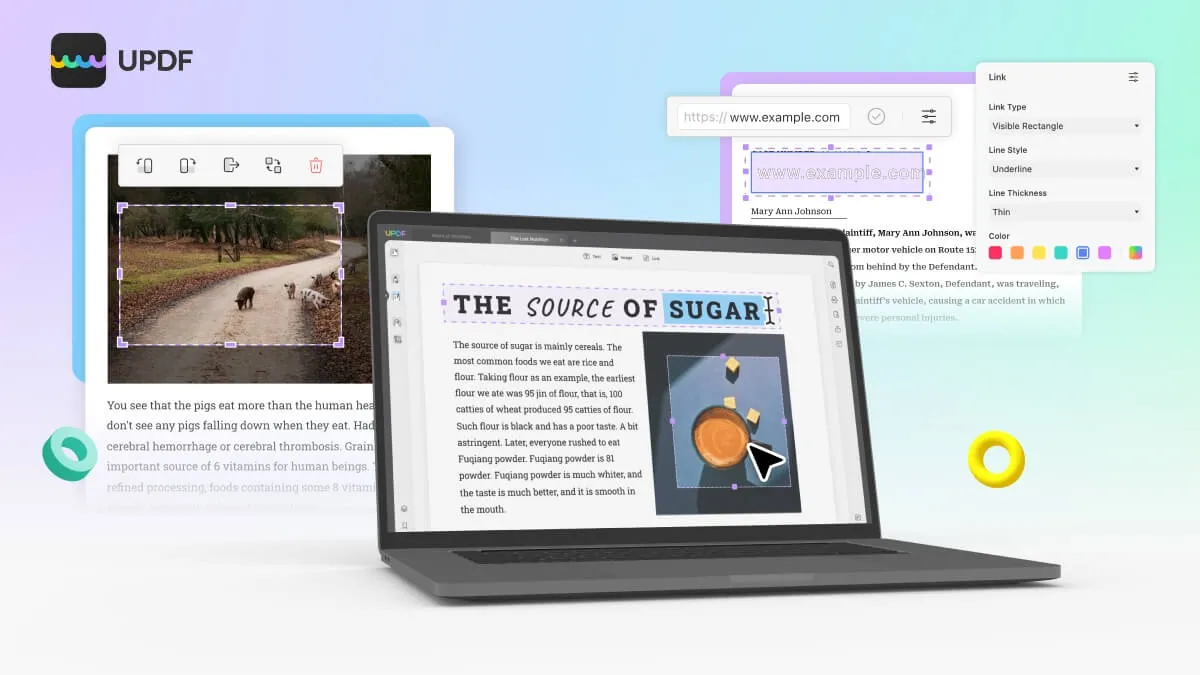
1: Browse the Template on Your Device
Start by opening UPDF on your system, tap the “Open File” button, and browse your planner template. After the template is open in UPDF, you can see its editable fields. You can easily add the content per the requirements by clicking these fields.
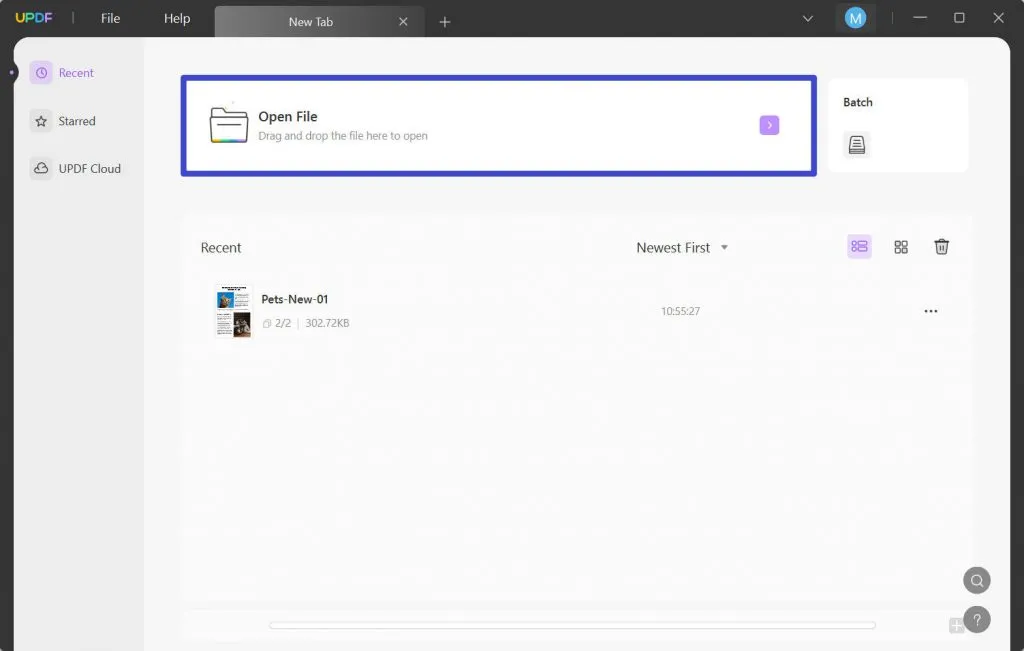
2: Insert Content into the Planner Template
If you want to insert additional content in your daily planner template, move to the left sidebar and opt for the "Edit PDF" tool. Select the "Text" section from the top bar and tap on the part of the file where you want to add the text. You can also insert customized texts by adjusting text font, size, and color.
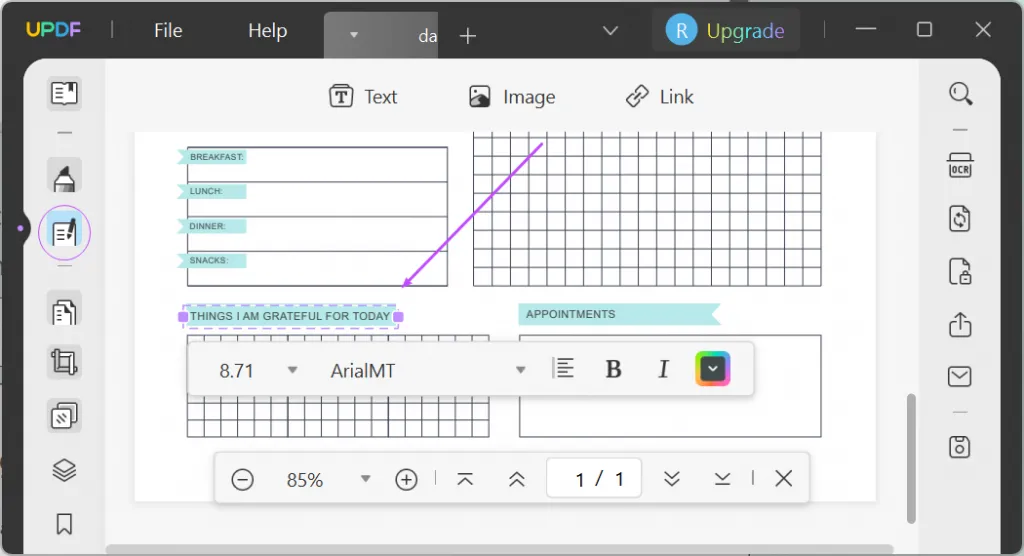
3: Save the Daily Planner Template
When you have finished editing, head to the "File" tab and press the "Save As" button. Fill in all the required fields, like file name and type, on the new window and click “Save” to save it successfully.
Windows • macOS • iOS • Android 100% secure
Step 4: Taking Notes or Writing Down Questions When Reading
Taking notes when reading is an effective way to help you retain information, better understand concepts, and remember key details. UPDF is a great tool for taking notes while reading. It offers a variety of features to help readers annotate, highlight, and organize their notes. One of its most useful features is scanning books or papers directly to take notes, saving time and effort.
Additionally, UPDF's comment features allow readers to add thoughts or questions directly to the text, making it easy to refer back to later. UPDF Cloud, where you can store PDF files, allows readers to access their notes anywhere and anytime. We highly recommend UPDF for students as it is a cost-effective tool offering a 50% education discount, thus making it even more affordable.
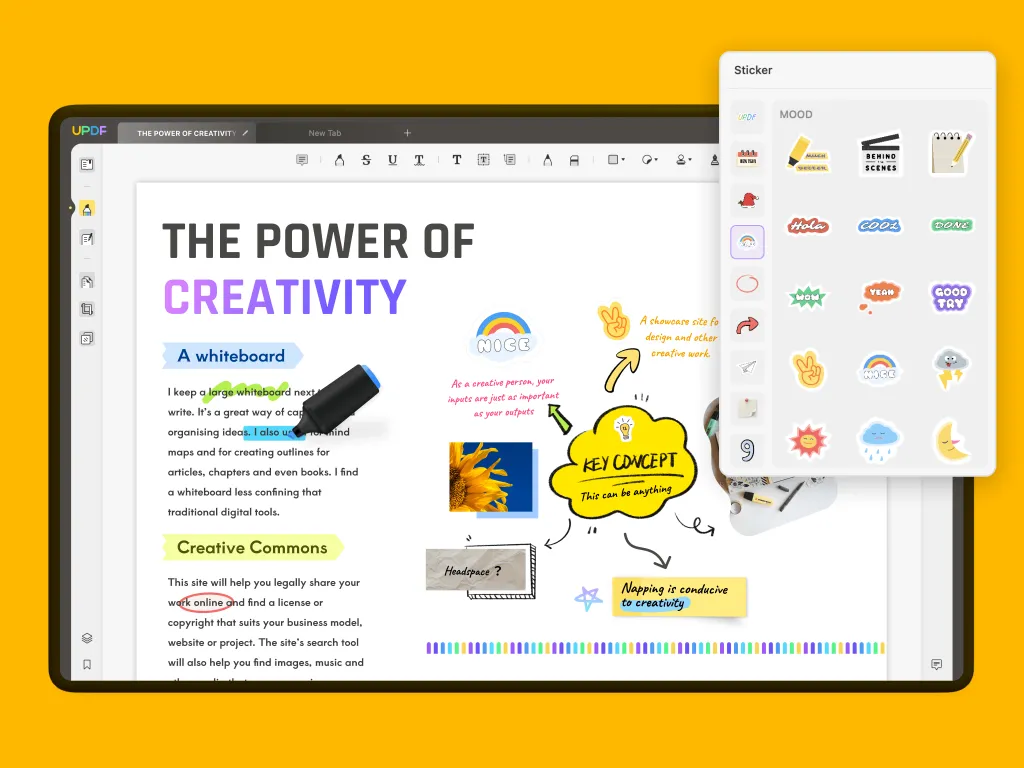
Step to Take Notes on this Advanced PDF Tool
Let’s learn how to start taking notes and adding questions to help students learn more effectively and improve their reading skills and strategies to the maximum level using UPDF:
1. Import the Blank File
First, launch the UPDF, navigate, and open the blank PDF file to add questions and notes by clicking the "Open File" button on the home page.
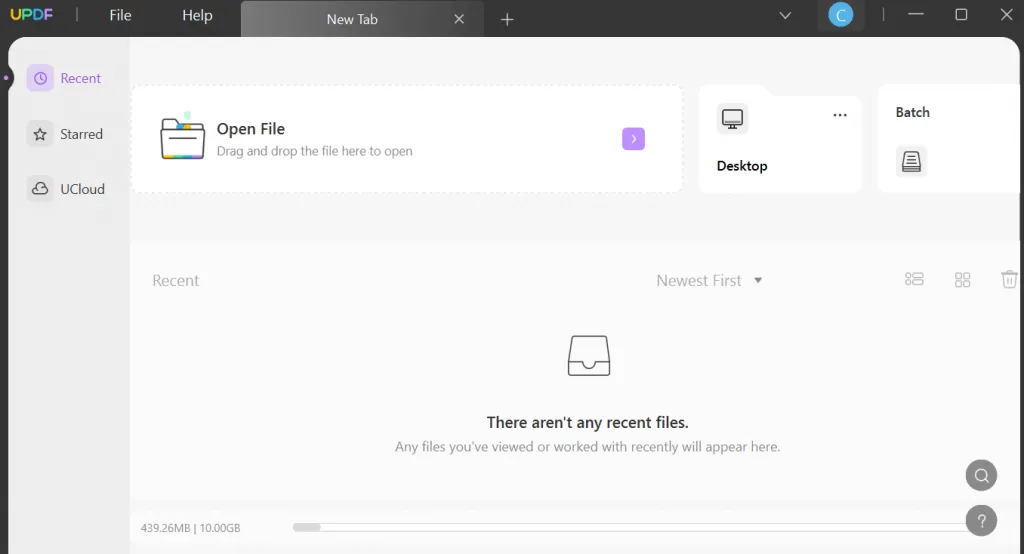
2: Explore Options to Add Texts
Head to the left sidebar, look for the “Edit PDF,” and click on it. Now, at the top bar, you will see various options. Select the “Text” option and click anywhere on the blank PDF to start writing notes or questions. Moreover, you can also change the font size, style, color, and alignment.
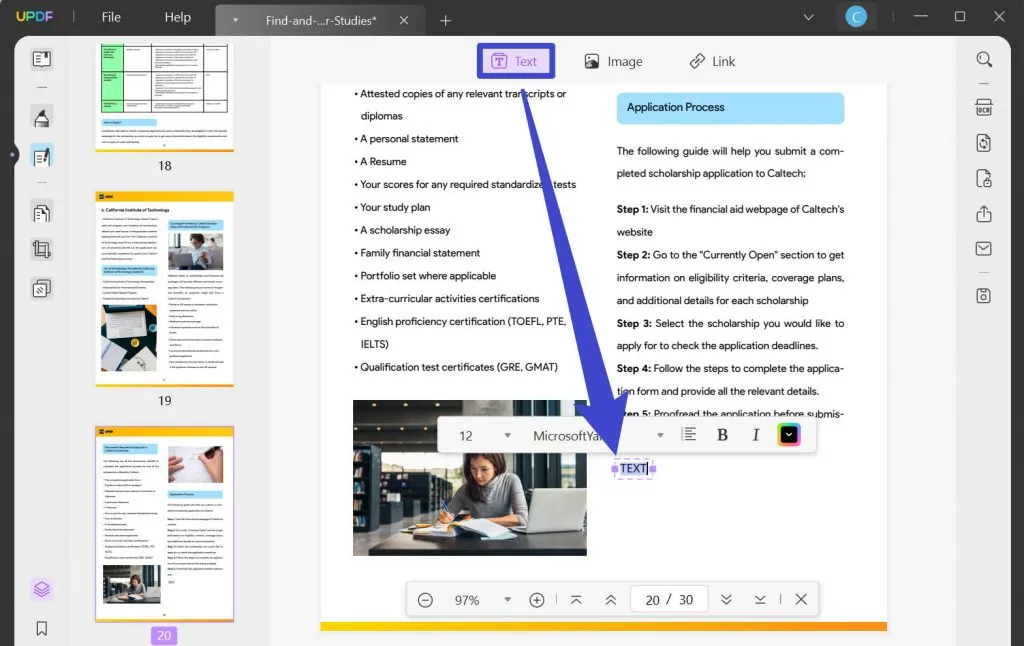
3. Enter the Comment Mode
Next, tap on the "Comment" icon in the left sidebar. You will see multiple annotation tools at the top bar, including highlight, strikethrough, underline, typewriter, stickers, sticky notes, and shapes. Choose any desired options to annotate the PDF as per need.
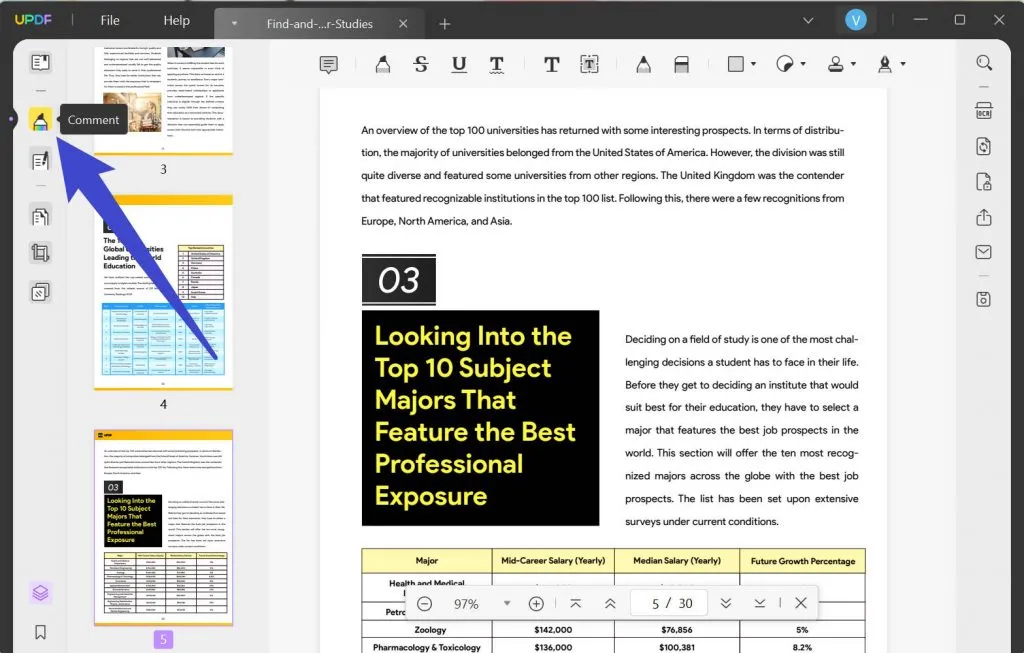
4. Add Notes to Your File
Tap the "Sticky Note" icon and click anywhere on your document to put the sticky note in that place. After that, you can write the notes in the pop-up window. Furthermore, you can also change the sticky note color.
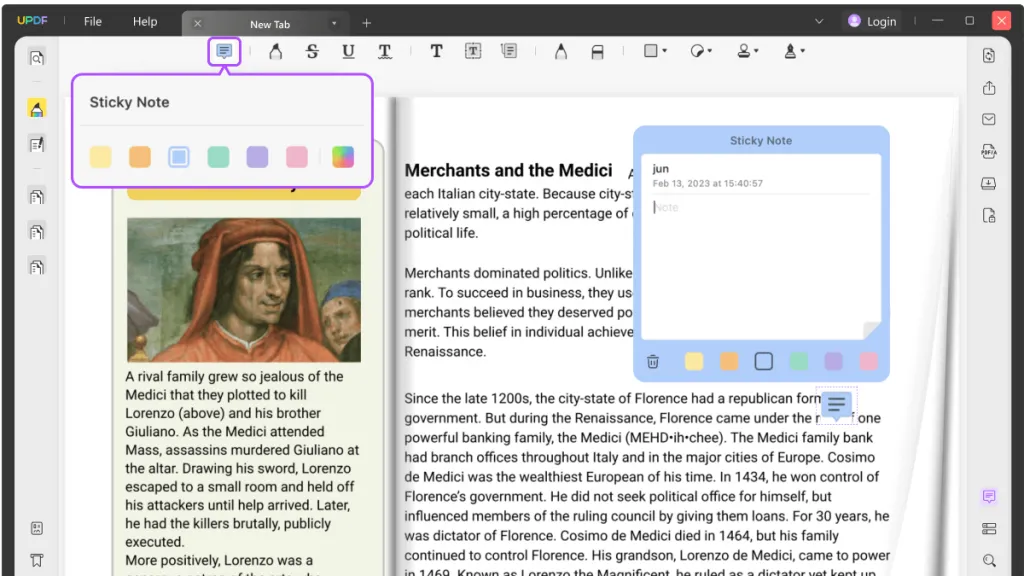
5: Save the File on the Device
After taking all the notes, head to the "File" tab at the upper left corner and select the "Save As" option from the drop-down menu. Type the file name and click the "Save" button to store the file on your device.
Windows • macOS • iOS • Android 100% secure
Step 5: Review Your Notes
Notetaking allows you to engage actively with your reading material, helping you better understand and retain the information. Reviewing your notes lets you identify key concepts, main ideas, and important details. This can help you to focus your reading and retain more information. Additionally, it can help you identify gaps in your understanding and allow you to seek clarification or additional resources.
Furthermore, reviewing your notes as a student effectively improves your reading skills, deepens your understanding of the material, and ultimately achieves academic success.
Step 6: Summarize Your Reading
Summarizing reading is a crucial skill for improving reading comprehension. It involves condensing a text’s key points and main ideas into a shorter version. Moreover, it helps to filter out irrelevant details and focus on the most important information. Some tips for effective summarizing include reading the entire text first, identifying the main ideas, taking notes, and using your own words to paraphrase the information.
With that, it is also important to check that the summary accurately reflects the text's main points and is written clearly and concisely.
Step 7: Finding a Reading Partner or Group to Discuss
Most of the time, reading can be challenging and sometimes overwhelming, especially when you are reading complex materials or trying to improve your basic reading skills. The best way to overcome these challenges is by finding a reading partner or group to discuss your reading materials with. A reading partner or group can provide motivation, support, and feedback to improve your reading skills.
A partner can be anyone who shares your interest in reading and is willing to engage in discussions about the reading materials. This is a valuable addition to your reading routine and can help you become a more confident and skilled reader.
Step 8: Introduce Your Reading Material to Your Friends
Introducing your reading material as a student can be a helpful way to improve your reading skills. When you share your reading with friends, you practice and reinforce your understanding of the material. Explaining concepts and ideas to others can help you solidify your understanding of the material, as you need to think critically about conveying it in a way that makes sense to someone else.
Additionally, your friends may have questions or perspectives you still need to consider, which can further deepen your understanding of the material regarding how to improve reading skills in students.
Step 9: Share Your Ideas About Your Reading Material on Social Media
This step is very valuable to help improve your reading skills and strategies in several ways. Firstly, it allows you to engage in active reading. When you share your thoughts and ideas about what you have read, you reflect on the material and connect the content with your experiences, knowledge, and perspectives. This reflection type can help improve your ability to retain and recall information.
Secondly, sharing your ideas on social media can help you receive feedback and engage in discussions with others who have read the same material to help you clarify your thoughts and develop stronger arguments and opinions.
Step 10: Reading Every Day
You need to develop this essential skill to succeed academically and in your career. Reading every day can help you improve your reading skills, which can have numerous benefits, including improving comprehension to train your brain to process information more quickly and efficiently. This can help you understand complex texts better and improve your comprehension.
This also exposes you to a wide range of vocabulary, which can help you expand your own vocabulary and improve your writing, communication, and critical thinking skills.
Final Words
Developing good reading habits, such as setting reading goals, choosing appropriate reading materials, and actively engaging with the text, can help students enhance their overall academic performance and reading skills. Furthermore, it is crucial to practice reading regularly, especially with more challenging texts.
Finally, using notetaking tools like UPDF can also be beneficial in improving reading skills. With UPDF, students can easily highlight important information, take notes, and organize their thoughts to review and remember the information later on.
Windows • macOS • iOS • Android 100% secure
 UPDF
UPDF
 UPDF for Windows
UPDF for Windows UPDF for Mac
UPDF for Mac UPDF for iPhone/iPad
UPDF for iPhone/iPad UPDF for Android
UPDF for Android UPDF AI Online
UPDF AI Online UPDF Sign
UPDF Sign Edit PDF
Edit PDF Annotate PDF
Annotate PDF Create PDF
Create PDF PDF Form
PDF Form Edit links
Edit links Convert PDF
Convert PDF OCR
OCR PDF to Word
PDF to Word PDF to Image
PDF to Image PDF to Excel
PDF to Excel Organize PDF
Organize PDF Merge PDF
Merge PDF Split PDF
Split PDF Crop PDF
Crop PDF Rotate PDF
Rotate PDF Protect PDF
Protect PDF Sign PDF
Sign PDF Redact PDF
Redact PDF Sanitize PDF
Sanitize PDF Remove Security
Remove Security Read PDF
Read PDF UPDF Cloud
UPDF Cloud Compress PDF
Compress PDF Print PDF
Print PDF Batch Process
Batch Process About UPDF AI
About UPDF AI UPDF AI Solutions
UPDF AI Solutions AI User Guide
AI User Guide FAQ about UPDF AI
FAQ about UPDF AI Summarize PDF
Summarize PDF Translate PDF
Translate PDF Chat with PDF
Chat with PDF Chat with AI
Chat with AI Chat with image
Chat with image PDF to Mind Map
PDF to Mind Map Explain PDF
Explain PDF Scholar Research
Scholar Research Paper Search
Paper Search AI Proofreader
AI Proofreader AI Writer
AI Writer AI Homework Helper
AI Homework Helper AI Quiz Generator
AI Quiz Generator AI Math Solver
AI Math Solver PDF to Word
PDF to Word PDF to Excel
PDF to Excel PDF to PowerPoint
PDF to PowerPoint User Guide
User Guide UPDF Tricks
UPDF Tricks FAQs
FAQs UPDF Reviews
UPDF Reviews Download Center
Download Center Blog
Blog Newsroom
Newsroom Tech Spec
Tech Spec Updates
Updates UPDF vs. Adobe Acrobat
UPDF vs. Adobe Acrobat UPDF vs. Foxit
UPDF vs. Foxit UPDF vs. PDF Expert
UPDF vs. PDF Expert



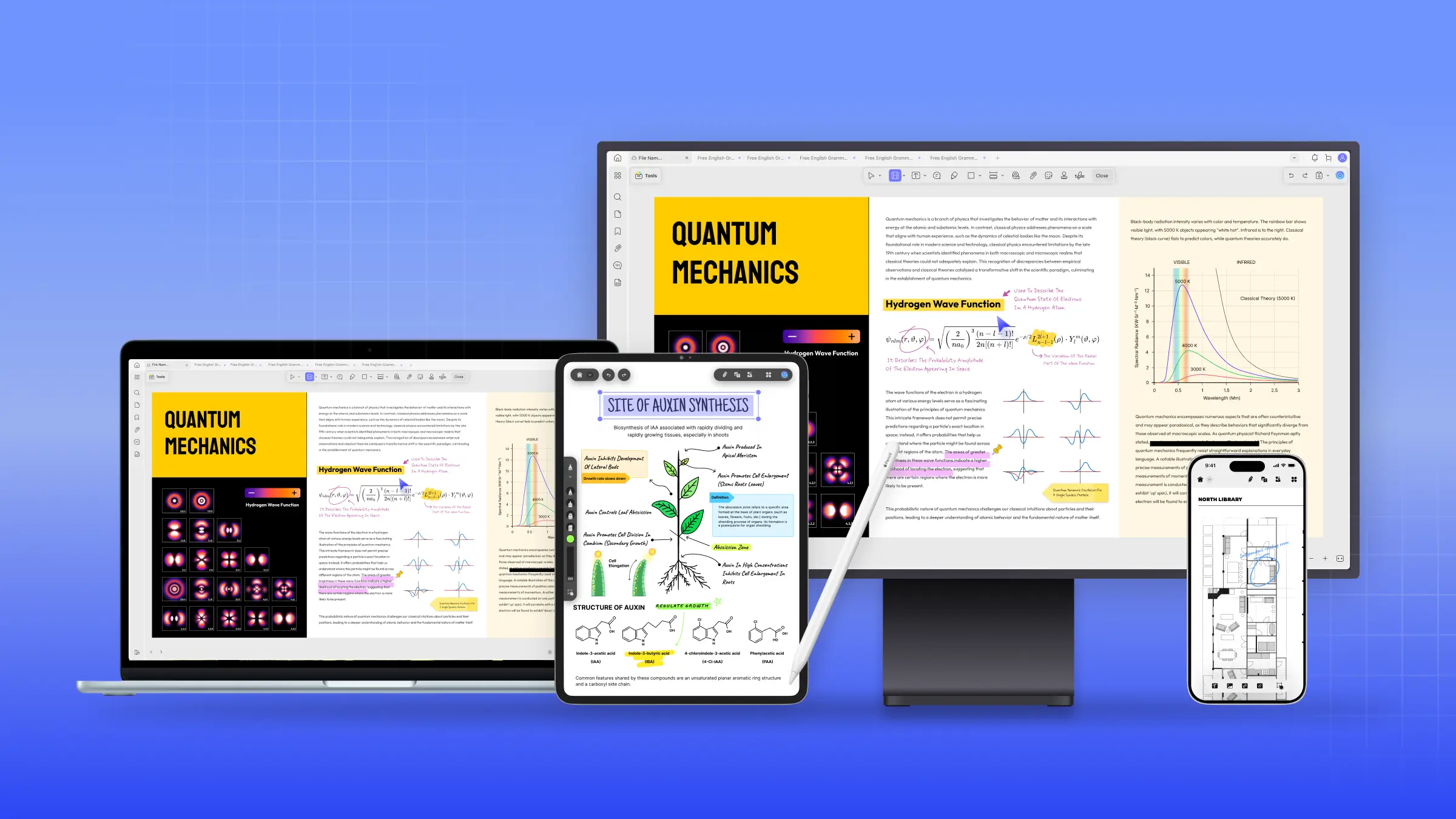




 Enola Miller
Enola Miller 


 Lizzy Lozano
Lizzy Lozano 